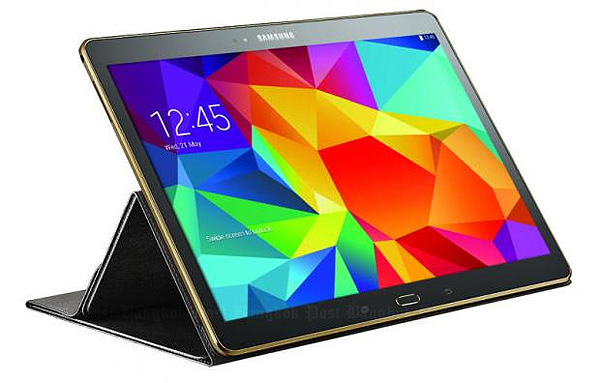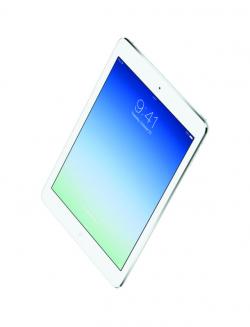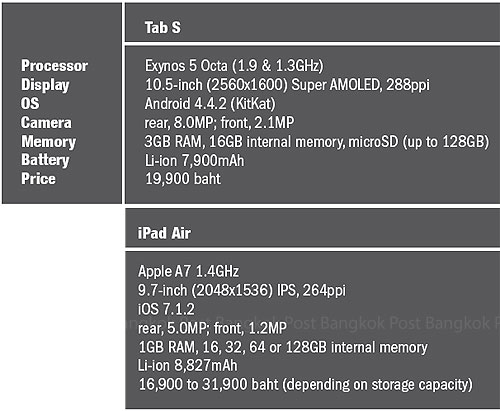
The Galaxy Tab S 10.5.
South Koreans take a big bite of the Apple iPad Air
For some years now, Samsung has been giving Apple a run for its money in the phone and tablet markets. Sometimes the Korean giant manages to outfox the American trendsetter and sometimes it can't quite pull it off. This week, we compare the two rivals' flagship tablets: the Samsung Galaxy Tab S 10.5 and the iPad Air. This is (as it should be) a close race that will have supporters of both camps sitting on the edge of their seats, although, from the point of view of this reviewer, Samsung has good reason to rejoice — and all because of its showing in a department in which Apple usually excels: the display.
Here's our category-by-category breakdown of the face-off between the two best tablets to come out this year (so far).
Design
Samsung is now using a faux leather for all its high-end products, including the Tab S, which makes for a welcome contrast with previous Samsung tablets, which often felt like bath toys. The firm's designers have also managed to get the thickness of the Tab S down to 6.6mm, making it slimmer than the iPad Air, and the svelte, eye-catching looks of this new tablet has earned it praise from several of my colleagues.
Meanwhile, with its full aluminium back cover, the iPad Air seems to have followed the lead of the iPad mini as far as design goes. The previous iPad model was both heavy and thick, but this new product is much lighter, a mere 465g. This is by far the best iPad we've used, although it doesn't boast anything novel in terms of design.
 The iPad Air.
The iPad Air.
Display
The Tab S uses Super AMOLED (the acronym stands for "Active Matrix Organic Light-emitting Diode") screen technology, identical to that installed in the Note 3 and the S5, and on a screen this size the results are gorgeous. The colours are rich, the contrast is high and the detail in photos and films looks much more "real".
The iPad Air is equipped with a retina display, a catchy term that wowed us a few years back, but because it's still using traditional LCD technology, it doesn't hold any surprises for me (or others). Don't get me wrong: it's great but that doesn't mean it's unbeatable. The time for AMOLED has arrived. If you doubt me, view the same photos or videos on both devices and compare. This is the first time I have felt Samsung has acquired an enviable feature.
Performance
As for specifications, the Tab S with two quad-core CPUs and 3GB of RAM runs smoothly. You can check your Facebook feed while simultaneously watching a 1080p video (split screen) — a true test of its performance.
However, in terms of benchmark features, it can't beat the iPad Air. There's only a 5% difference in their GeekBench 3 score. For Android's benchmark, since it doesn't use the powerful Snapdragon CPU, the Antutu score is behind both the Galaxy S5 and the Note 3. Apple's custom-designed A7 chip is the fastest in its line and with its own iOS, it's a combination that offers a great performance despite the inferior specs.
Storage
The iPad Air (comes in space grey or silver) is available in 16, 32, 64 and 128GB models, with either Wi-Fi-only or 4G LTE capability. Prices start at 16,900 baht for the 16GB Wi-Fi-only version. The 128GB 4G model retails for 31,900 baht.
The Tab S offers only one model, 16GB, and it's priced at 19,900 baht. For colours, you get a choice of dazzling white or titanium bronze. Thanks to the expandable microSD slot on the Tab S, both tablets can offer up to 128GB of internal memory, but the iPad comes out as 30% more expensive.
Connectivity
Even though both have 4G capability, only the Tab S can make phone calls. So, if you want an all-in-one device, put this new Samsung on your shopping list. Remember, though, that when it comes to making calls, you have to use either the speakerphone or a headset; a Bluetooth headset is possible but still inconvenient.
The SIM card for the iPad Air is for internet connections, so no phone calls, SMS or MMS on this device. The upcoming software update, an iPad running iOS 8, will have the ability to make and receive phone calls or send SMS if both iPhone and iPad are connected to the same Wi-Fi network.
Software
The Tab S and the iPad Air both run the latest version of its in-house operating system (OS): Android 4.4 and iOS 7, respectively. On the OS part, kitkat is fast, filled with features and can be customised to fit a user's needs. The funny thing is that the majority of users don't know how to do this customisation (change app launcher or overclock CPU speed).
The iPad Air's advantage in this category comes from the strength of its app store. Developers can't keep up with the Android screen diversity. Some apps on the Tab S are stretched and pixelated because they weren't made for this resolution.
Which makes tailor-made iOS tablet apps look great on the Air by comparison. By playing the Iron Man 3 game on both devices, I instantly noticed the superior quality of the iPad Air. Apple give away free an iLife and iWork suite (lifestyle and productivity apps) which gives users the ability to start work on a Mac and finish it on an iPad via iCloud.
Notable features
Samsung's SideSync feature allows you to drag files back and forth between the Samsung Galaxy smartphone and the tablet, and even answer calls without picking up your handset (This includes controlling all apps). Apple's iOS 8 has the same feature, called "Continuity", but it can also interact with Mac computers.
The Tab S has multiwindow mode, which lets you line up two apps side by side. The iPad still lacks this feature but it is rumoured that iOS 8 will bring this to the iPad Air.
The Tab S has an IR blaster and fingerprint scanner, two features which the iPad lacks. However, I haven't had a chance to test the fingerprint scanner yet since it was disabled on the model I got for review. Security on mobile devices is getting tighter and there are rumours that the next-gen iPad Air will be equipped with TouchID too.

Camera
Judging from a hands-on try-out of both devices, the Galaxy Tab S camera feels pretty much on par with the iPad Air. The noise is low and the shutter is quick, but it is still not good enough to replace your camera. If you're a selfie lover or want high-res photos of your vacation, you'd be better off buying a dedicated camera. The Tab S has the advantage of a wider range of features for tablet shutterbugs.
Verdict
Samsung has finally created a great tablet. It is fast, full of features and has the best screen of any tablet presently on the market. The firm should build on this success and not just change to another formula. Add-on such as apps or accessories will make users confident to use this.
Think of it as a gaming platform; a great console will fail if it lacks AAA+ games to run on it.
Stop creating more 7, 8, 8.4, 10.1 and 10.5 tablets; it's already too confusing out there! The upcoming iOS 8 promises features that will help your iPhone, iPad and Mac work closely together; pick up a phone call on your iPad or start some work on a Mac and edit it on an iPhone. However, Samsung delivered this months before Apple did (Samsung only supports the Galaxy S5 and not all models).
The Samsung Tab S has beaten the iPad Air by a long stretch in a category in which Apple once dominated. Apple fanboys think the iOS 8 will help Apple even up the fight, but Apple should consider installing some new technology in the next version of its iPad rather than just giving us yet another redesign.
For the moment at least, Samsung is the clear winner in the tablet stakes.
comments powered by Disqus

